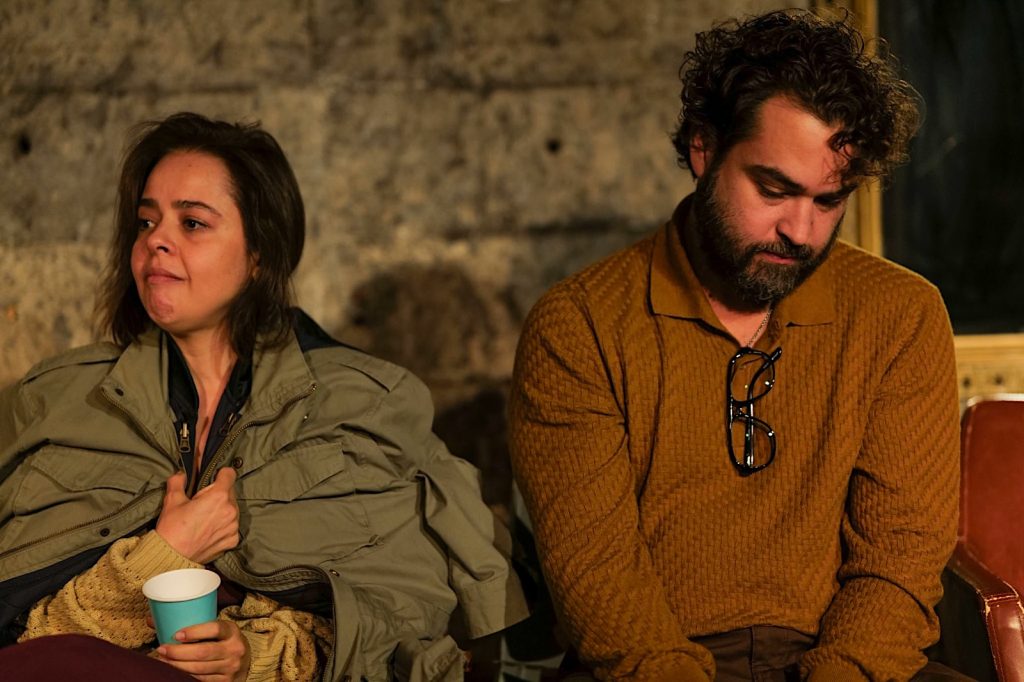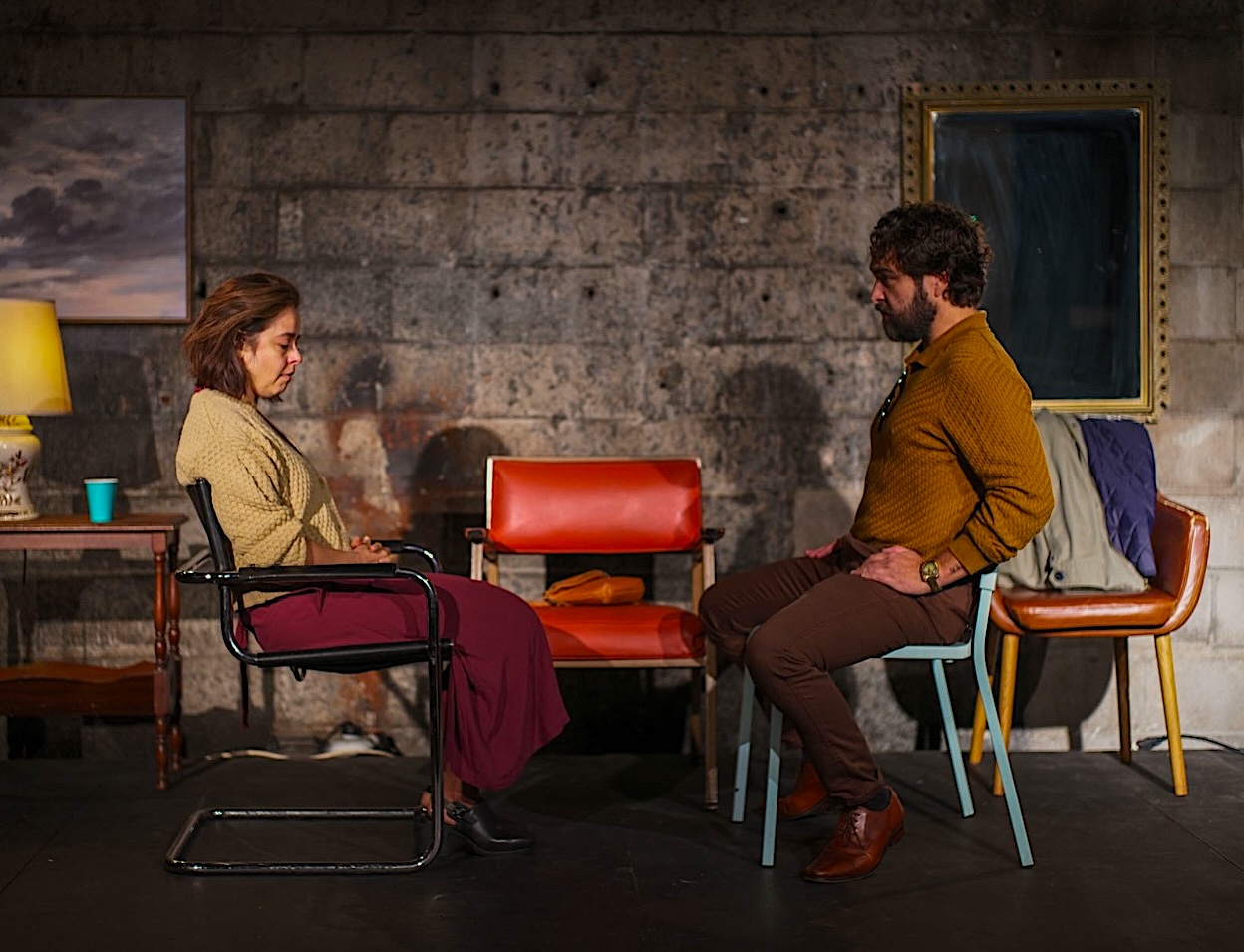BY STEPHEN DiLAURO |
“Poison”
by Lot Vekemans
at Unit J in Brooklyn, through Dec. 1
“Poison” is an evocative play for anyone who has experienced grief and/or an absence of closure. The two-character offering was written by Dutch playwright Lot Vekemans. Her English-language translator is Rina Vergano. The new staging of the piece, which was first produced on 42nd Street at Theatre Row in 2016, is at Unit J in Brooklyn. This unusual theater and music performance space is a quick ride on the L train to Wilson Avenue and then a three-minute walk.
The play is set in the waiting room of a cemetery. A formerly married couple rendezvous there at the ex-wife’s request. The ostensible reason is that their son’s grave must be relocated due to industrial contamination that threatens the local groundwater.
Emma Ramos is by turns vulnerable, devastating and tragicomic in her bravura performance as the woman. The man’s role appears to be the more difficult, with its demands of a good-guy demeanor that is tested to the max. Richard Carrillo does a first-rate job in a nuanced performance at odds with both the past and his immediate present.
Both actors benefitted from the expert direction of Katina Medina Mora, who has over the past several years become a sought-after commodity in TV and movies. In addition to her original Spanish-language feature films, she directed the Netflix hit miniseries “Selena,” as well as “Emily in Paris” and “XO, Kitty” and Apple TV’s “Swagger.”

Mora was born in Pittsburgh, raised in Mexico and educated in London. Word is that she has several offers to direct her first English-language feature film. “Poison” is her New York City debut as a stage director.
Unit J is in an old industrial building. The space has been converted and is the spacious and totally bohemian home of the production’s male lead, Carrillo, who is also a musician. Everyone is offered a glass of wine upon arrival, quite a civilized touch.
Whether or not you’re someone able to invoke “everything happens for a reason” regardless of circumstance, “Poison” is effective in clarifying that grief is necessary, but can become self-indulgent. Such is our humanity. A very worthwhile evening, all in all.
For more information and tickets, click here.
“Colored Silk: A Civil War Journey” (closed)
Tami Tyree gives a powerful, touching performance as Elizabeth Keckley in “Colored Silk: A Civil War Journey.” Keckley was the dressmaker to both Mrs. Abraham Lincoln and Mrs. Jefferson Davis, as well as to Robert E. Lee’s wife. “Women and dresses saved my life” is a line early in the show.
Elizabeth Keckley was born into slavery. Her first owner was her father, who “loaned” her to neighbors for sex beginning at an early age. Eventually, Keckley’s half-sister owned her. It was through the largesse of Southern high society women, for whom she made dresses, that Keckley was able to purchase her and her son’s freedom and move north to Washington, D.C., not long before the Civil War broke out.
Tyree drew her dramatic material from a book Keckley wrote that was published in 1868 and from extant letters. Her memoir was titled “Behind the Scenes: Or, Thirty Years A Slave and Four Years in the White House.”
The show opens with a powerful singing performance by Tyree, who can also be heard on the soundtrack of the movie “12 Years a Slave” and other recordings. She is the artistic director of a group called Echoes of Our Ancestors African American History and Song, which creates history programs for purposes of education and entertainment.
Andrew Horton and Laura Bowman both make cameo appearances as readers of letters. For some reason, Tami Tyree and her director, Jordan Achan, made the choice to introduce a fourth player, Ras Chemash Lamed a.k.a. Herb Grant, to sing at the end of the show. And there I was eagerly anticipating an end with another song by Tyree.
This is not the first theatrical adaptation of Elizabeth Keckley’s story. It is an admirable addition to this legacy. I saw “Colored Silk” at The Players Theater on MacDougal Street, which has presented theatrical production since the 1930s. At the very least, perhaps pared down to a solo performance, “Colored Silk” would suit any educational institution with a design curriculum.
Poets at Play:
“The Second Oswald”
by Andrei Codrescu, with Bob Holman
at Bowery Poetry Club
Bowery Poetry Club was packed as two prominent poets took the stage to perpetuate fascination with the circumstances and conspiracies surrounding the death of President John F. Kennedy 60 years ago. There were some conspiracy theorists there, for sure.
At one point in the evening a guy, I’m guessing in his fifties, pointed to Bob Holman and said to me, “You and that guy have the same haircut. What’s with that? Did you plan that?” I asked him if he was a freemason. He said “no” and I walked away. I ignored whatever he said to my back. It was that sort of evening.
“The Second Oswald” is about Kerry Thornley, a poet and writer who served in the Marines with Lee Harvey Oswald and wrote a book about him that was published a year before J.F.K.’s assassination. He also founded something called Discordianism, which I admit to being totally unfamiliar with.
The stage version for this one-night-only show consisted of Holman, who I’ve known since he was Allen Ginsberg’s literary secretary, and Codrescu, who is a frequent NPR contributor, reading the one-hour script. If it’s to go further as a stage presentation, it requires dramaturgical attention. But it was a lot of fun and the crowd was amiable.
The second act, if you will, was a discussion between Codrescu and writer and editor Jesse Walker, who wrote “The United States of Conspiracy.”
Fortunately, there’s a more in-depth rabbit hole in the form of Codrescu’s “The Second Oswald” podcast, if you’re so inclined. Two things I learned that night: Aldous Huxley and C.S Lewis died that same day as J.F.K. Could that really be a coincidence?
The Poe Room
Twice a year, Edgar Allan Poe is honored at New York University with a presentation. What is presented varies. I went, for the first time, and saw Campbell Harmon’s portrayal of Poe. His rendition of “The Tell-Tale Heart” was a powerful crowd-pleaser. Lois Rakoff, the community director for the Poe Room at N.Y.U., was charming, and everyone who attended was treated to a buffet dinner. There was an open wine and beer bar where the actor, still in character and costume. answered questions. Poe was in his milieu, if you will.


Wrong Bob! My pal Bob Rosenthal was Allen’s secretary. Read his book, STRAIGHT AROUND ALLEN. Thanks for the review!
Please excuse my confusion, Bob. Let me buy you a beer sometime soon.